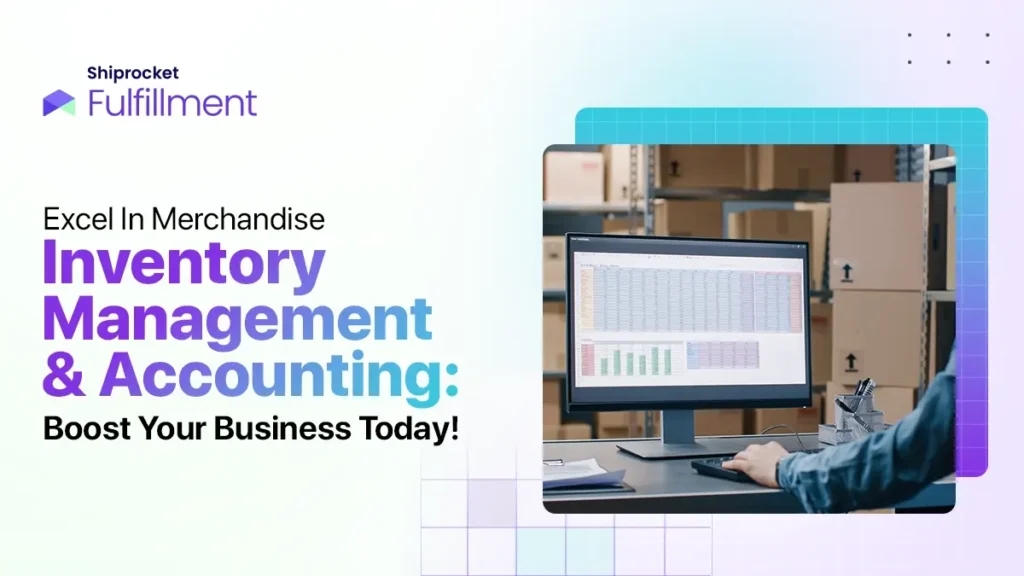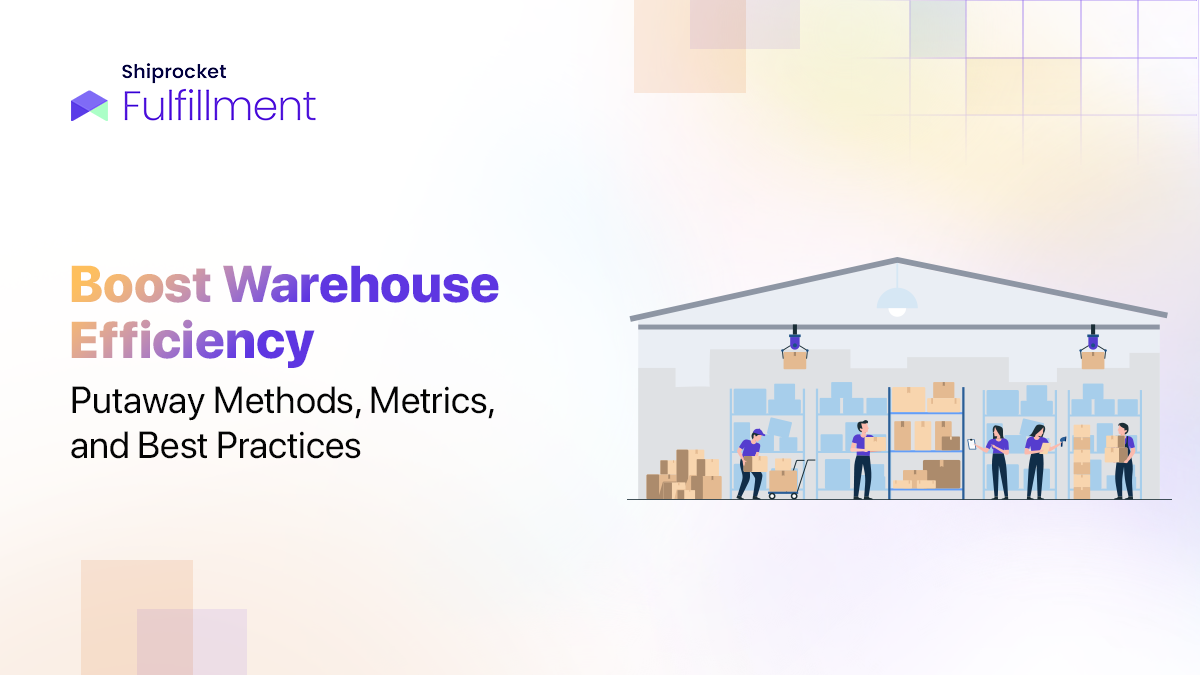- What is Merchandise Inventory?
- The Significance of Merchandise Inventory in Accounting
- A Closer Look at the Contents of Merchandise Inventory
- Analysing Merchandise Inventory in Income Statements
- Understanding Merchandise Inventory Turnover
- Exploring Various Methods for Managing Merchandise Inventory
- Efficient Techniques for Calculating and Monitoring Merchandise Inventory
- Illustrated Examples of Merchandise Inventory Management
- Streamlining Merchandise Inventory with Shiprocket Fulfillment
- Conclusion
Inventory is a valuable asset on the balance sheet of your business, regardless of its size. It is a crucial accounting tool, connecting production to order processing. Inventory holds significant value for a company’s balance sheet, regardless of its size or type of business. For numerous companies, this inventory of goods available for sale, commonly referred to as merchandise inventory, stands as their most valuable asset.

Mastering merchandise inventory is like holding the key to your company’s success, influencing not just your earnings but also your competitiveness, efficiency, and customer satisfaction. Let’s explore how merchandise inventory shapes your business success.
What is Merchandise Inventory?
Merchandise inventory is the value of goods a business intends to sell for profit. It is a valuable asset, comprising items purchased from suppliers with the aim of selling them to customers. These items include finished products or materials used for manufacturing. The cost of these goods becomes an expense when sold. If unsold, their cost is considered a current asset until they are sold.
The Significance of Merchandise Inventory in Accounting
Keeping track of merchandise inventory is really important in accounting, especially for online businesses. Accurate inventory management and tracking are vital, directly impacting a brand’s financial well-being. Below mentioned are a few significances of merchandise inventory in accounting:
- Financial Impact: Keeping track of your inventory directly affects how well your business is doing financially.
- Avoiding Risks: Ensuring you control your inventory well helps prevent issues like missing items, running out of stock, or having too much on hand.
- Improvement with Numbers: Using metrics, like how quickly your inventory is selling, helps you manage and find things more easily.
- Knowing What’s Available: Metrics, such as how fast your inventory is selling, show you how quickly you can turn it into cash and avoid keeping things that don’t sell well.
- Financial Impact: Your inventory affects significant financial numbers like what you own now, what you owe, your expenses, and your profit.
- Understanding Gross Profit: Accurate accounting is super important because it directly affects how much money you make after considering all your costs, contributing to your overall financial health.
A Closer Look at the Contents of Merchandise Inventory
Merchandise inventory provides a comprehensive view of the products and the financial aspects of their acquisition and sale. It encompasses various costs incurred by a retailer to obtain products for sale. Merchandise inventory comprises both the initial cost of items purchased by the retailer and additional expenses incurred by the company, such as shipping, insurance, and storage. It comprises all purchased goods in warehouses, retail stores, in transit from suppliers, or on display in various locations. This inventory category also encompasses all unsold stock ready for sale, whether in stores or warehouses.
Analysing Merchandise Inventory in Income Statements
Merchandise inventory is listed as an asset on a company’s balance sheet, however, it doesn’t directly affect the income statement. It includes details of revenue, expenses, and profit or loss for a specific accounting period. However, the income statement is impacted by merchandise inventory.
When a company sells items from its merchandise inventory, the costs of those items are actively reflected in the Cost of Goods Sold (COGS) expenses on the income statement for that particular period.
Understanding Merchandise Inventory Turnover
Merchandise inventory turnover is an essential measure for stores. It shows how quickly a store sells and restocks its goods. To calculate it, divide the cost of goods sold by the average inventory. This metric helps with pricing, promotions, and managing suppliers and stock. High turnover is usually good because it means the store is selling things quickly and not keeping too much money tied up in unsold items. However, different types of stores have different turnover rates. Grocery stores and fast-fashion shops usually have higher turnover than luxury stores. A healthy business needs efficient merchandise inventory turnover for reasonable control and money flow.
Exploring Various Methods for Managing Merchandise Inventory
Businesses choose between the perpetual inventory system and the periodic system to manage merchandise inventory based on size and preferences. Perpetual inventory involves real-time updating of stock levels, while periodic inventory refreshes information at set intervals rather than continuously. Here is a detailed view of both methods to understand what is best for your business:
Perpetual Inventory Method:
Large retailers primarily adopt the perpetual inventory method. It involves achieving real-time updates through Point of Sale (POS) systems, which automatically record every transaction, including sales. This reduces errors, ensuring continuous and accurate views of current inventory levels. It’s suitable for businesses with high transaction volumes.
Periodic Inventory Method:
Smaller retailers often favour the periodic inventory method. It relies on physical inventory counts at the end of each accounting period, providing less frequent but comprehensive updates. This manual tracking approach suits businesses with lower transaction volumes, although it lacks the real-time insights of the perpetual method.
Efficient Techniques for Calculating and Monitoring Merchandise Inventory
Efficiently calculating and monitoring your merchandise inventory is crucial for your retail operation. To determine the ending merchandise inventory at the close of your accounting period, follow these steps:
- Calculate Your Beginning Merchandise Inventory:
- Your beginning merchandise inventory is the inventory value at the start of the period before acquiring additional items or selling any existing inventory.
- The beginning inventory for the current period is simply the ending merchandise inventory value from the previous period.
- Compute Your Merchandise Inventory:
- Add the amount spent on additional inventory during the period to your beginning inventory.
- Subtract the Cost of Goods Sold (COGS) from the total.
Formula to calculate:
Ending merchandise inventory = beginning inventory + new inventory costs – the cost of goods sold (COGS)
These merchandise inventory calculations go beyond financial statements. They help with inventory reconciliation, identifying and addressing issues like shrinkage due to errors, theft, or spoilage. Additionally, they assist in determining inventory write-offs for tax purposes. Leverage trends in your inventory to optimise your ordering strategies.
Illustrated Examples of Merchandise Inventory Management
Let’s delve into an example from X, a company specialising in bulk cleaning products, to understand merchandise inventory management. In a specific timeframe, they sold 12,000 cleaning products at $25 each, acquired 600 goods, and had 480 products in stock. The accountant navigates the calculations, armed with data revealing a cost of goods sold at $250,000, purchased inventory of $12,000, and ending inventory at $9,000.
Using the beginning inventory formula, the accountant determines a beginning merchandise inventory of $246,000.
Using the formula:
Ending merchandise inventory = beginning inventory + new inventory costs – cost of goods sold (COGS)
The merchandise inventory is then calculated as ($246,000 + $12,000) – $250,000, resulting in $8,000. This indicates that X possesses $8,000 worth of inventory ready for sale in that accounting period.
Streamlining Merchandise Inventory with Shiprocket Fulfillment
Navigating supply chain challenges is crucial for eCommerce and retail firms. Shiprocket Fulfilment stands out as a valuable solution in this context, offering support to mitigate risks and enhance supply chain resilience. Leveraging Shiprocket Fulfillment streamlines merchandise inventory for businesses, addressing disruption risks and strengthening supply networks. Services cut costs, enhance efficiency, and improve the customer experience strategically. With 42+ fulfillment centers nationwide, the platform ensures prompt deliveries, streamlines operations, and integrates with 12+ sales channels. Covering 24,000+ pin codes and excelling in B2B order fulfillment, Shiprocket enhances overall business performance by optimising the supply chain. Utilise the tech stack to elevate your supply chain, ensuring efficient eCommerce fulfillment with a 20% reduction in shipping costs.
Conclusion
Understanding merchandise inventory is crucial as it directly influences accurate financial calculations, expense management, and overall profitability. This knowledge guides resource allocation and prudent spending on inventory. Insights into the company’s financial health help in making informed decisions. Reporting this essential number aids in setting revenue goals and monitoring key performance indicators for inventory. Ultimately, a well-managed merchandise inventory contributes to sustained financial success and operational efficiency, positioning your company for long-term growth and success in the competitive market.
Another term for merchandise inventory is simply “inventory.” It’s a current asset with a normal debit balance, meaning a debit increases it, and a credit decreases it.
A debit to accounts payable is made for any unsold product inventory within a certain accounting period. Additionally, fresh purchases of goods will be shown as a debit from accounts payable and a credit to the inventory account.
No, inventory of items is a present asset that is anticipated to be sold. Property that a firm owns or rents and uses for operational reasons is referred to as a long-term asset.





